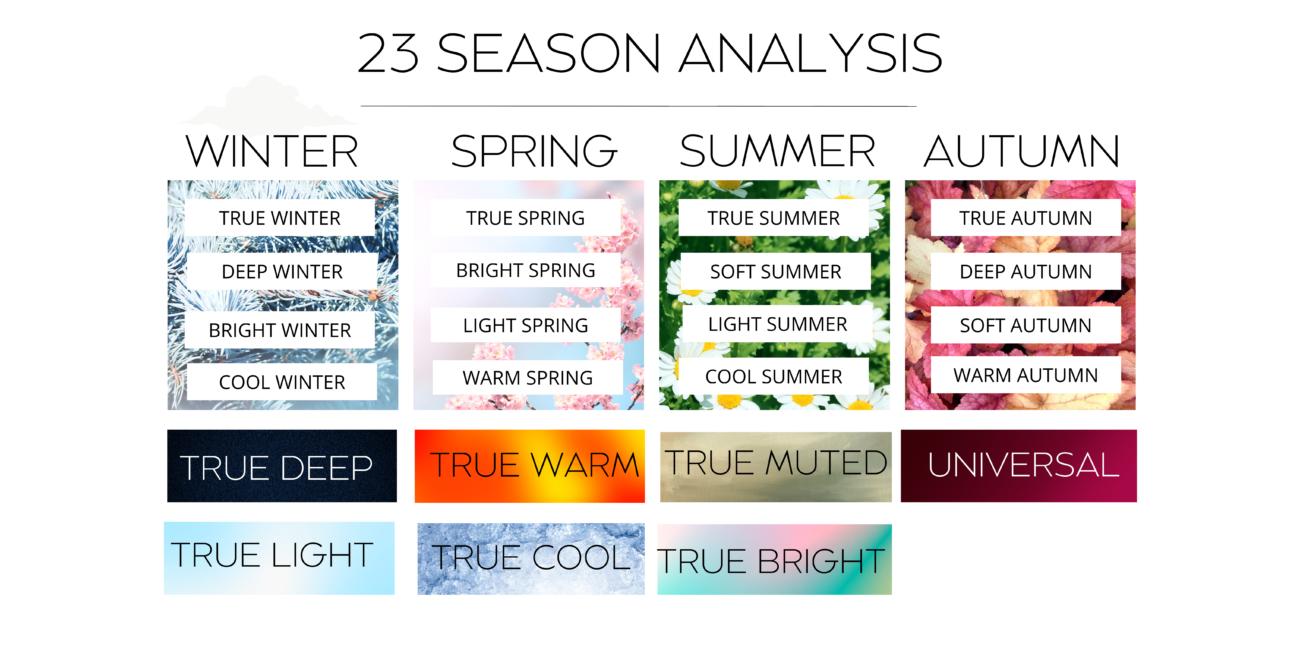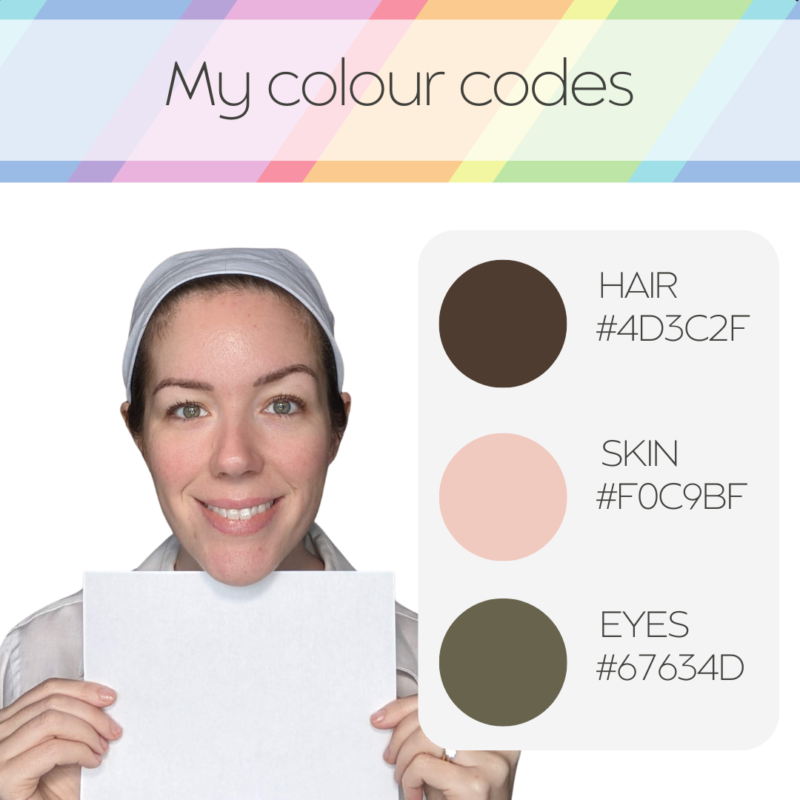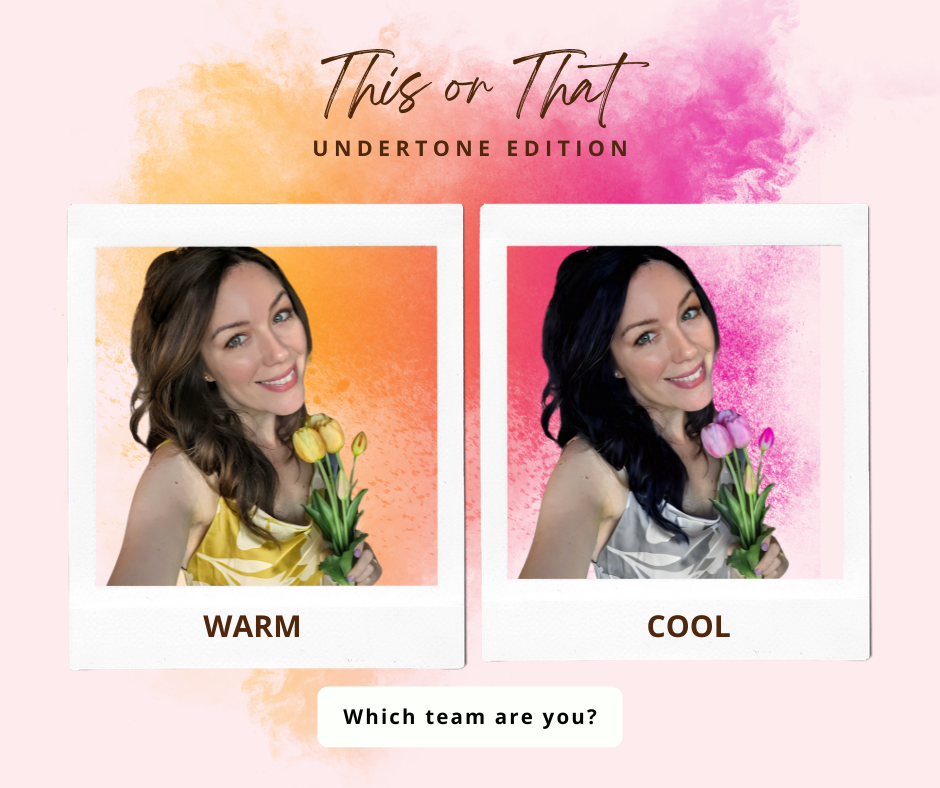Blog
Our Ultimate Guide to Colour Analysis Systems

The world of color analysis is fascinating, but it can also be quite confusing with all the different systems out there. In this blog post, we’re breaking down some of the major color analysis systems to help you understand each one, along with their advantages and disadvantages.
The systems we are looking at are:
- Seasonal Color Analysis
- Tonal Colour Analysis
- Expanded Seasonal Analysis (sometimes referred to as 12 Season Analysis)
- Beauty Profiling
- Sci/ART (sometimes referred to as 12 Season Color Analysis)
- 16-Season Color Analysis
- The 23 Palette System used by Pristmatic Style
And yes, there are plenty more systems out there than just these ones!
1. Seasonal Color Analysis (4 Season Analysis)

The 4-Season Color Theory System, which emerged in the 1980s, laid the foundation for color analysis by categorizing people into four groups based on their cool or warm characteristics: Summers, Winters, Springs, and Autumns.
This system uses the basic color wheel, with cool colors on the left and warm colors on the right. People with cool traits (eyes, hair, and skin) were classified as Summers or Winters, while those with warm traits were considered Springs or Autumns.
Although some view this system as outdated compared to advanced systems, it is the basis on which all the other seasonal analysis systems are built – it remains a significant starting point and is accessible to those attempting to self analyze. Understanding whether you have a warm or cool undertone is a great place to start to help you choose the right jewelry, metals, and makeup shades, enhancing your natural coloring but may lack the wow factor of a more comprehensive system.
- Advantages: Simple and easy to understand. A great starting place for self-analysis.
- Disadvantages: Limited to four broad categories.
2. Tonal Color Analysis

Introduced in 1987, Tonal Analysis focuses on the quality or tone of colors rather than seasonal categories.
Tonal analysis goes beyond seasonal classification by describing your color palette with dominant, secondary, and tertiary traits (dominant is listed first). The six tonal directions are Warm, Cool, Deep, Light, Clear, and Soft. For example, you might be classified as Warm, Light, Clear, or Cool, Deep, Soft.
This system can be used alongside the 4 season palette assessment for best results in finding your most flattering colours.
- Advantages: Focuses on color tone, flexible.
- Disadvantages: Can be less intuitive for some people. Can be difficult to align to seasonal palettes. Difficult to self analyze as it requires a knowledge of colour theory. Lack of neutral categories.
3. Expanded (12 Season) Seasonal Analysis

The 12-Season Color System theory builds on the traditional 4-season system by dividing each season into three more precise categories, resulting in 12 distinct seasons. This system identifies each person’s dominant color characteristic—light, dark, warm, cool, soft, or clear—and a secondary characteristic to determine their specific season. This secondary factor helps refine color recommendations, making it easier to find the most flattering shades.
For example, someone with deep coloring could be either a Deep Winter or Deep Autumn, depending on whether cool or warm colors suit them better. Similarly, a Light person could be a Light Spring or Light Summer. The system acknowledges overlaps between seasons, such as Clear Spring and Clear Winter sharing colors like emerald green, and Cool Winter and Cool Summer sharing violet and deep rose.
- Advantages: The more nuanced approach allows for more accurate and personalized color analysis by considering dominant characteristics first and then refining it with a secondary trait.
- Disadvantages: Difficult to categorize individuals with neutral colouring. Overlap between seasons can be confusing.
4. Beauty Profiling

Combining color analysis with energy profiling, this system developed in the 2000s offers a holistic approach to personal style and color choices.
The methodology works through Energy Profiling, where individuals assess their primary energy type based on personality, behavior, physical traits, and preferences, alongside self-observation. This determines a personalized Color Palette aligned with their natural energy to guide choices in clothing, accessories, makeup, and hair color.
- Advantages: Creates a colour palette that will align with the individual’s personality and style.
- Disadvantages: Less focus on traditional color analysis – colour palettes are not draped and traditional colour analysis checks are not performed.
5. Sci/ART

This system, established in 2004, utilizes the Munsell color system to classify individuals into 12 categories. The Sci\ART method emphasizes scientific method and colour theory in determining it’s clients season. Individuals are analyzed based on their skin tone, eye color, and natural hair color to determine their season. This is done through draping sessions where different colored fabrics are placed near the face to observe the effect on the person’s appearance.
- Advantages: Scientific basis in Munsell color system, detailed analysis considering all colour dimensions.
- Disadvantages: Requires professional consultation due to complexity. Lack of neutral categories.
6. 16 Season Colour Analysis

The 16 Season Color Analysis, developed in the 2000s, expands the 4 and 12-season systems by adding more subcategories. Each of these four main seasons is divided into four sub-seasons, resulting in 16 distinct categories. These sub-seasons account for variations in undertone (warm vs. cool), value (light vs. dark), and chroma (clear vs. muted).
The True Seasons added reflect a combination of colour dimensions (ex. True Spring – a balance of warmth and brightness, True Winter (also referred to as a cool deep Winter) – a balance of cool and dark, True Autumn – a balance of warm and dark, True Summer – a balance of cool and soft).
- Advantages: Highly specific, gives a tailored experience to the client.
- Disadvantages: Can be overwhelming, very detailed. Lack of neutral categories.
7. 23 Palette Color Analysis – *USED BY PRISMATIC STYLE*

The 23-palette color analysis system developed by the International Image Institute in the 1990s is a highly refined and detailed method for personal color analysis. This system further expands the traditional and intermediate seasonal color analysis models, providing even more nuanced categories to help individuals find their most flattering colors.
It combines and expands on other methods of analysis and is grounded in scientific basis and colour theory. The results of this analysis will last a lifetime as it is based in your genetics.
This is the only system that caters to fully neutral colour dimensions. It even has a universal season for the exeedingly rare few that are perfectly balanced neutrals in every colour dimension. For some individuals that have neutral dimensions and have been previously typed in a system that was not designed for their characteristics, they may feel more seen in this system of analysis and are more likely to be accurately matched to their best colours by a professional trained in this analysis methodology.
- Advantages: The 23 palettes offer a highly detailed categorization, allowing for very precise and personalized color recommendations. The system can accommodate a wide range of skin tones, eye colors, and hair colors, making it inclusive and adaptable.
- Disadvantages: The level of detail requires expertise and time to complete. Accurate use of the system requires a highly knowledgeable analyst.
Conclusion
Color analysis offers a fascinating journey into understanding how to enhance your natural beauty by aligning your wardrobe with your inherent traits. From the foundational 4-Season Color Theory to the more nuanced 12-Season and 16-Season Systems, each method brings its own advantages and challenges.
While all these systems have their merits, the 23-Palette System stands out for its ability to provide a highly personalized and detailed analysis. By offering a wide range of palettes, it caters to the subtle variations in individual coloring, making it easier to find the perfect shades that enhance your natural features. This system not only considers your undertones but also integrates your dominant and secondary characteristics, resulting in a more comprehensive and accurate color analysis. It’s also the perfect system for those that suspect they may have neutral undertones, value or intensity in their natural colouring.
If you’re looking to refine your style and discover the colors that truly complement you, the 23-Palette System is highly recommended. Its detailed approach ensures that you’ll have a well-rounded understanding of the colors that suit you best, helping you make informed decisions about your wardrobe and personal style. Embrace the journey of color analysis and unlock the potential to look and feel your best every day.
Virtual analysis with Prismatic Style is available on our website. In person analysis with Prismatic Style is based in Victoria, BC Canada.





